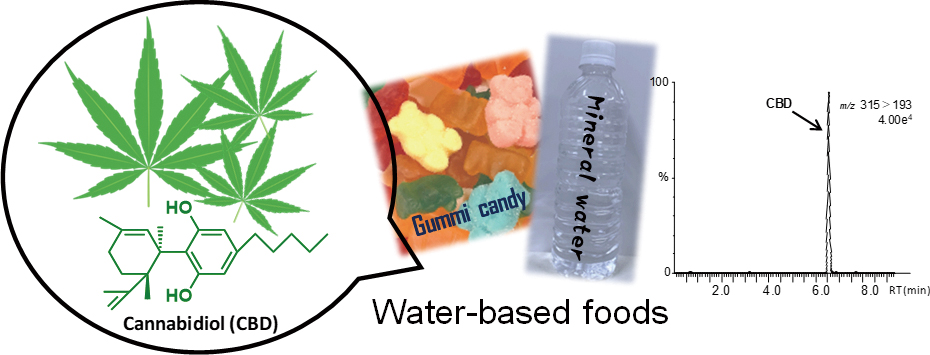- 著者
- Shiori Takashina Miki Takahashi Koji Morimoto Koichi Inoue
- 出版者
- The Pharmaceutical Society of Japan
- 雑誌
- Chemical and Pharmaceutical Bulletin (ISSN:00092363)
- 巻号頁・発行日
- vol.70, no.2, pp.169-174, 2022-02-01 (Released:2022-02-01)
- 参考文献数
- 17
- 被引用文献数
- 5
Cannabidiol (CBD), a major non-psychoactive cannabinoid, has a lot of attention due to its potential relaxing properties and led the trend in commercial CBD aroma/oral hemp seed oil from the Japanese market. In this study, a routine assay for evaluating CBD oil samples was performed using LC coupled with tandem mass spectrometry (LC-MS/MS) and was used to apply the convertible tetrahydrocannabinol (THC) in acetic acid conditions. Based on the electrospray positive ion mode, the detection of cannabidiolic acid (CBDA; m/z 359 > 219), cannabigerolic acid (CBGA; m/z 361 > 343), cannabigerol (CBG; m/z 317 > 193), CBD (m/z 315 > 193), THC (m/z 315 > 193) and cannabinol (CBN; m/z 311 > 223) was performed by satisfying separation with high density of C18 column. Oil samples (50 mg) were diluted with isopropanol (5 mL), to which stable isotope internal standards were added by dilution with methanol/water (50/50), and accuracy rates ranged from 97.8 to 102.2%. This method was used to evaluate the CBD oil products (5 kinds) from the Japanese market. Our survey found obvious counterfeit (non-detectable CBD) CBD oil from Japanese market. Following that, we investigated the conversion of THC in CBD oil samples in simple conditions such as 10% acetic acid and 70 °C for 6 h and discovered that converts THC proportions are approximately 5% ((THC content/CBD content) × 100) and <1.0%. Thus, our developed LC-MS/MS assay could be applied to monitor the CBD concentration and convertible THC from CBD oil.
- 著者
- Shiori TAKASHINA Yuki IGARASHI Miki TAKAHASHI Yukie KONDO Koichi INOUE
- 出版者
- The Japan Society for Analytical Chemistry
- 雑誌
- Analytical Sciences (ISSN:09106340)
- 巻号頁・発行日
- vol.36, no.11, pp.1427-1430, 2020-11-10 (Released:2020-11-10)
- 参考文献数
- 23
- 被引用文献数
- 10
A sensitive, useful and preliminary screening method was proposed to quantitate the containable cannabinoids most commonly included in mineral water and gummi candy products, specifically cannabidiol (CBD), cannabinol (CBN), 11-nor-9-carboxy-Δ9-tetrahydrocannabinol (THCA), cannabigerol (CBG), and cannabidiolic acid (CBDA), using liquid chromatography coupled with tandem mass spectrometry (LC-MS/MS) for quality evaluations. Based on the electrospray positive ion mode, the limit of detection and the limit of quantification values were 0.2 to 0.5 ng/mL and 0.8 and 2.0 ng/mL. Samples (0.5 g) were diluted by water/methanol (50/50), to which stable isotope internal standards were added; the recovery results appeared in range from 91.3 to 101.2%. This method was applied to evaluate CBD products (6 kinds) from the Japanese market. Our survey found obvious discrepancies between the labeling and the results were overserved in products. In addition, CBN, THCA, CBG, and CBDA were not detected in full-spectrum products that contained various cannabinoids that naturally occur in the cannabis plant. Thus, it is necessary to be able to verify the accurate concentration and impurity in various CBD products from the Japanese market as quickly as possible.
- 著者
- Shiori TAKASHINA Yuki IGARASHI Miki TAKAHASHI Yukie KONDO Koichi INOUE
- 出版者
- The Japan Society for Analytical Chemistry
- 雑誌
- Analytical Sciences (ISSN:09106340)
- 巻号頁・発行日
- pp.20N015, (Released:2020-07-24)
- 被引用文献数
- 10

